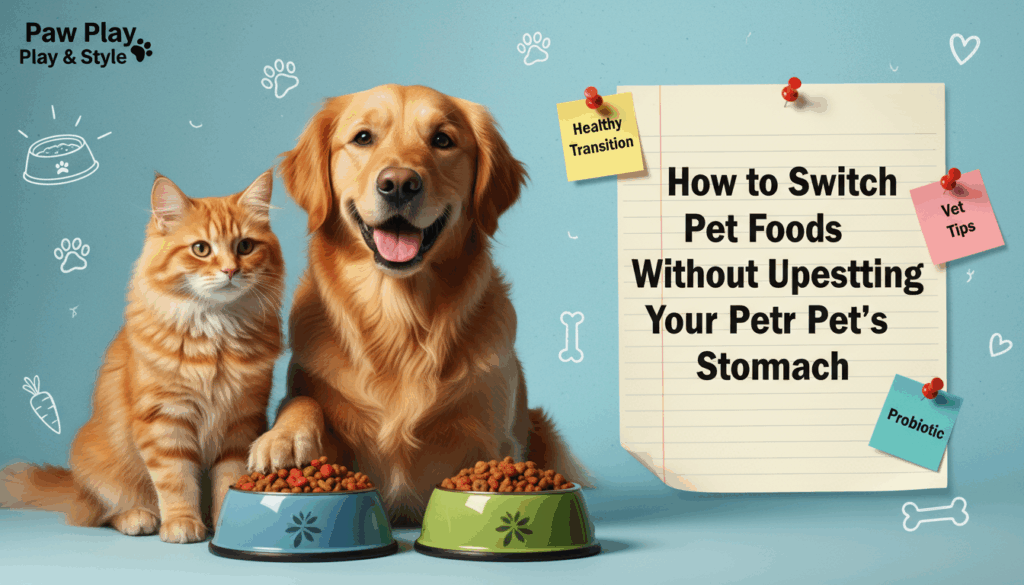Switching your pet’s food might seem like a simple task—just pour the new kibble into the bowl, right? But for many dogs and cats, a sudden change in diet can cause digestive issues such as diarrhea, vomiting, excessive gas, or even refusing to eat altogether.
The good news is that with the right approach, you can safely transition your pet to their new food without causing tummy troubles. This guide will walk you through a step-by-step food transition plan, common mistakes to avoid, and vet-approved tips to make the process smoother for your furry friend.
Why Slow Transitions Matter
Your pet’s digestive system is home to a complex community of gut bacteria that adapt to their current diet. When you abruptly change their food, their digestive system doesn’t have enough time to adjust, which often results in digestive upset. A gradual transition allows their stomach to gradually balance out and reduces the risk of stress or discomfort.
Step-by-Step Transition Plan (7–10 Days)
Here’s the schedule recommended by veterinarians for a safe and effective transition:
Days 1–2: 75% old food + 25% new food
Days 3–4: 50% old food + 50% new food
Days 5–6: 25% old food + 75% new food
Day 7+: 100% new food
Tip: If your pet has a particularly sensitive stomach, extend the transition period to 10–14 days. Slow and steady always wins the race!
Signs You’re Moving Too Fast
Watch for these red flags during the transition process:
Loose stools or diarrhea
Vomiting
Excessive gas
Refusal to eat
If you notice any of these symptoms, pause at the current mix for a few more days before moving on to the next step. It’s crucial to move at a pace that suits your pet’s digestive system.
Pro Tips for a Smooth Transition
Use a Probiotic Supplement
Benefits: Probiotics support healthy gut bacteria, aiding digestion during the food change.
Example: Purina Pro Plan FortiFlora (available for both dogs and cats).
Stick to a Feeding Schedule
Why it matters: Consistency in feeding times helps your pet’s stomach adjust to the new food.
Suggestion: Consider using an automatic pet feeder for precise feeding times. (👉 Affiliate tie-in: Automatic pet feeders)
Add Digestive-Friendly Toppers
Examples: A spoonful of pumpkin purée (plain, unsweetened) or goat’s milk can help soothe digestion during the transition.
Choose the Right Formula
Why it’s important: Pick a food that matches your pet’s age, size, and health conditions. Opt for gentle-transition foods or foods for sensitive stomachs.
Example: Hill’s Sensitive Stomach & Skin (for dogs) or Royal Canin Digest Sensitive (for cats).
Where to Buy: Check availability on Amazon, Chewy, or Petbarn.
Stay Hydrated
Tip: Make sure your pet is drinking enough water. Wet food or a pet water fountain can encourage better hydration, which aids digestion.
Common Mistakes Pet Parents Make
Avoid these common pitfalls during the transition:
Switching foods too abruptly: Changing food too quickly can shock your pet’s digestive system.
Mixing too many new treats: Too many treats during the transition can complicate things.
Ignoring portion guidelines: Not following feeding guidelines can lead to overeating.
Overlooking health conditions: Always consider your pet’s health (e.g., allergies or kidney issues). Check with your vet if your pet has medical needs before making dietary changes
Recommended Products for a Smooth Transition
Here are some recommended products that can help ease the transition to your pet’s new food:
Probiotics for Pets: Support healthy digestion and maintain a balanced gut microbiome during the food transition. Purina Pro Plan FortiFlora is an excellent choice for both dogs and cats.
Slow Transition Foods: Foods designed for sensitive stomachs or limited-ingredient diets can make the switch easier. Options like Hill’s Science Diet Sensitive Stomach & Skin or Royal Canin Digestive Care are gentle and nutritionally complete.
Feeding Accessories: Tools like timed feeders, puzzle bowls, and water fountains can help maintain consistent feeding schedules and encourage hydration during the transition period.
These products are designed to improve your pet’s comfort during the transition, making the switch easier and healthier for your furry friend.
Final Thoughts
Changing your pet’s food doesn’t have to lead to upset stomachs or messy clean-ups. By following a gradual transition plan, using probiotics, and choosing the right feeding tools, your dog or cat can adjust smoothly to their new diet.
Next Step for Pet Parents: Select a high-quality food designed for your pet’s needs, follow the 7–10 day transition plan, and consider adding a probiotic supplement for extra support. Your pet’s tummy will thank you!

